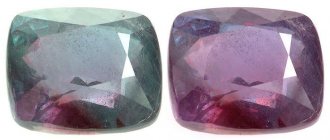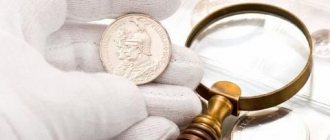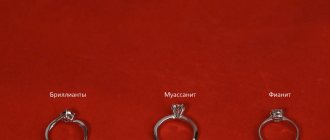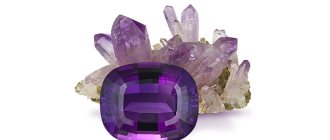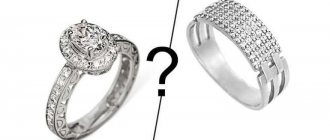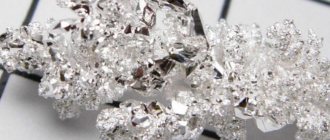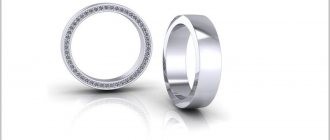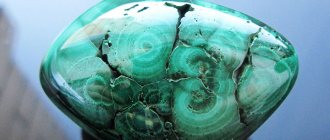Alexandrite was first discovered in the Urals in the 19th century. At first, the gem was mistaken for an emerald. Only when we noticed that it was stronger and changed color depending on the lighting, we realized: this is a new mineral. A real stone is rare; the price of some specimens far exceeds the cost of diamonds. Therefore, it is important to know how to distinguish natural alexandrite from artificial one. Otherwise, instead of the desired unique crystal, you can purchase a fake.
What does the stone look like?
Alexandrite is chrysoberyl with the addition of chromium and vanadium. A high-quality stone is transparent and rich in color.
Such specimens are unique; less transparent, cloudy crystals are more common.
A bluish-green gemstone is common; olive specimens with shades ranging from yellow to brown are less common.
Features of alexandrite are pleochroism and three mandatory colors: green, dark red, yellow with orangishness. They can be complemented by blue or lilac.
They say about it that it is an emerald during the day and a ruby in the evening. It looks different in different lighting: during the day it is pure green or with a bluish or yellowish tint. In artificial light it turns red or has orange or purple hues. This property is called pleochroism or color reversal.
The property of changing color depending on lighting is also called the alexandrite effect.
| Property | Description |
| Formula | Al2BeO4 |
| Color | In daylight: dark blue-green, bluish green, dark grass green, olive green. In evening or artificial light: pink-crimson, red-violet, purple. |
| Shine | Glass |
| Transparency | Transparent, translucent |
| Hardness | 8,5 |
| Cleavage | Imperfect |
| Kink | Conchoidal |
| Density | 3.5-3.84 g/cm³ |
Peculiarities
To understand how to distinguish natural alexandrites from counterfeit copies, you need to have specific knowledge about the nature of the stone and its distinctive features.
Its birefringence characteristics are 0.008-0.010. The color of genuine jewelry is exclusively bright red, yellow or green. The stone sometimes shows changes under ultraviolet light, and will appear red under fluorescent light. Daylight will help the stone develop a blue-green hue, sometimes just green or green-yellow. When it comes to artificial light, alexandrite can appear red, red-orange, and also red-purple.
Important! If you bring a magnet to a stone, it may be attracted, but very rarely, or not react at all.
What to consider when buying a gem
Alexandrites are small, up to 2-3 carats. Unique items larger than five carats are listed in catalogues. All specimens are supplied with a certificate (gemmological examination certificate) confirming their naturalness. If there is no document, there is no need to distinguish the original from the fake, everything is clear. However, the document itself requires verification: authenticity is established by contacting the organization that issued it. Information about issued certificates is posted on the official websites of companies.
True alexandrite
Real alexandrite can be found in pre-revolutionary domestic jewelry. Soviet jewelry contains artificial inserts.
High quality crystals weighing two to three carats cost $22-39 thousand per carat. Grayish specimens with weak pleochroism fetch $320-550 per carat.
The most expensive alexandrite was sold by Christie's auction house for $206 thousand almost thirty years ago.
Synthetic and natural analogues
To distinguish alexandrite from a fake, you need to know what stones are similar to it. There are synthetic gems, grown in laboratories and industrial conditions, and natural ones, but belonging to other groups of minerals. The color of the stones may be very similar to their natural counterpart, but they will differ in hardness and reverse.
The jewelry industry does not stand still, and very plausible imitators of alexandrite have appeared.
Similar to alexandrite:
- Synthetic corundum, that is, artificial stone. It perfectly conveys the color of alexandrite, has increased hardness and even shimmers in all shades of the spectrum. However, if a corundum gem is held up to light, the mineral will turn yellow. The original stone will shimmer in many shades, including yellow. But this color will not become dominant in the overall color scheme. Even 30-50 years ago, corundum was widely used to imitate alexandrite in many jewelry. Nowadays this is rare.
- Synthetic spinel. Widely used in the manufacture of jewelry with imitation alexandrite. It reproduces the color shades of the original well, but the spinel completely lacks the yellow color. This stone comes in many shades, changing color from pink to blue. In daylight, spinel has a violet-blue hue, while alexandrite shimmers from green to red.
- Glass. By adding special chemical elements (chrome, nickel) to a regular glass alloy, jewelers can get stones very similar to alexandrite. However, they will be almost half as hard as the original. Such a fake will be inexpensive, but it’s not worth talking about good quality.
Alexandrite can also be replaced by natural precious stones, which will resemble the original in shade. This phenomenon is called pleochroism.
A successful analogue would be:
- Ruby. You won't be able to spot a fake on your own. The minerals have a very similar color scheme, and ruby also has an orange color in the palette. In terms of cost, the products will be in the same price category, both with ruby and with alexandrite.
- Tourmaline. The watermelon variety of the gem is often passed off as the original. Tourmaline shimmers from red to green, but depending on the angle of the incident rays, the shade of the stone will be different.
- Andalusite. Green stones are used for imitation. They are framed in silver, but the cost will be inferior to the original.
- Zircon. Even an ordinary person can distinguish such a fake, because the stone will not change its color at all.
- Pomegranate. Minerals containing chromium may pass for the original. But garnet does not have blue or lilac highlights, unlike alexandrite.
What is offered instead of alexandrite?
Under the guise of a mineral, they offer substitutes of different types and origins:
- artificial crystals;
- cheaper natural gems: garnet, ruby, spinel;
- glass.
Only glass is considered fake. The first two are imitations of alexandrite, since they copy the characteristics or are natural minerals.
Synthetic imitation
You can get an artificial analogue in two ways: growing it from scratch in the laboratory (the cheapest is the hydrothermal method) or enriching a mineral of a lower class with chromium and vanadium.
Types of alexandrite
They learned to grow crystals a hundred years ago (Czochralski method). The first artificial alexandrite was obtained by the Americans from lithium compounds. The Soviet Union synthesized it nine years later, in 1973.
Corundum. The best imitation. The spectrum contains three colors, so the basic characteristics of the stones do not differ much from the original. “Alexandrite” inserts of jewelry from the times of the USSR are made from them. In the USA, artificial crystals produced in Russia are sold as natural African, Brazilian, and Ceylon crystals.
Natural gems
For imitation, gemstones of a lower class with similar properties are taken. Popular “sources” are tourmaline, ruby, andalusite, zircon. Pyrope and grenades are rarely used.
It is guaranteed to distinguish between ruby and natural alexandrite after studying the material under a microscope: hardness, color, and other characteristics are similar. It is difficult to identify green andalusite, but it is a rare stone, so it is almost never used as an imitation.
Glass
A cheap option for counterfeiting expensive stones. Jewelry glass is enriched with chromium; crystal (Swarovski crystals) is less commonly used.
Inserts are used in costume jewelry.
Properties
Synthesized alexandrite is more in demand in modern jewelry, since the natural stone is quite rare, and the price, accordingly, is also quite high. In laboratories, stones are created based on natural particles of alexandrite obtained by cutting natural stones.
Hydrothermal stone has greater transparency and purity, and has no foreign impurities. As for the color range, modern technologies make it possible to form stones of any color from green to purple while maintaining the effect of iridescence and trichroism. Such stones are much cheaper than their natural counterparts, while outwardly retaining all its qualities, and other properties are almost identical.
How to determine the origin of a crystal
If the gem does not have a document, it is not an alexandrite. In this case, it is worth figuring out what type of artificial stone is chosen for the product. The properties of alexandrite help to establish the origin: a range of colors, pleochroism, indifference to ultraviolet radiation (the gem sometimes fluoresces slightly red), a weak reaction to magnets.
Alexandrite
Synthetic imitation
It is easy to distinguish a natural mineral from a synthetic one by the following characteristics: artificial is often larger than three carats, it has increased purity, and the internal bubbles are spherical (drop-shaped in natural ones).
Alexandrite. It is indifferent to magnets and fluoresces brightly orange in ultraviolet light.
Spinel. The most popular artificial “understudy”, which can be distinguished by the following characteristics:
- in daylight, a range of shades without yellow;
- in the sun, violet dominates, without greenery and bright red tints;
- the price is several times less than that of alexandrite.
The cost of artificial spinel is comparable to amethyst, citrine, and aquamarine.
Corundum. During the day, a bright yellow color appears, which is barely noticeable in alexandrite.
It is possible to determine the authenticity of such crystals at home only to a first approximation.
Natural gems
Minerals with “Alexandrite” characteristics are used as imitation: chromium content and pleochroism effect.
Natural alexandrite
You can recognize the stone yourself:
- Ruby. Visually indistinguishable from the original, the range of shades includes orange. The cost is not much lower, so imitation is rarely used.
- Tourmaline. Pleochroism depends on viewing angle, not lighting.
- Grenades, pyropes. A rare imitation. Garnet has no blue tints; the crystals are attracted by a magnet. Pyropes lack yellowness and multi-colored glare.
- Sapphire, spinel. Deprived of the daytime alexandrite scale.
- Andalusite. The colors change when you turn the stone.
Zircon, amethyst or spodumene are so different from alexandrite that the imitation is visible even to an inexperienced connoisseur.
Glass
The easiest way to distinguish alexandrite from a fake of this type is:
- shimmers like a rainbow in the light;
- Easily scratched by a needle.
Artificial material does not have pleochroism. The colors are brighter, but not as deep.
Facts from history
Alexandrite was discovered by Finnish researcher Nils Nordenskiöld. He first came across it in 1834 on April 17, and initially mistook it for an emerald, as it had a similar deep green color and low refractive characteristics. But the only difference immediately noticed was the increased hardness index.
Arriving home, the mineralogist decided to continue his research and, when he took out the stone, he was surprised, because it was no longer green, but had a pronounced red color.
But there is another version about how the stone was first found. Perhaps this happened in Yekaterinburg on the Tokovaya River, where it was also confused with emerald. But after a detailed analysis of the properties in St. Petersburg, where he was immediately sent, it became clear that this was a completely different jewel.
If it weren’t for Alexander’s birthday then, most likely, the stone would have been called “diaphanite” - that’s what Lev Perovsky, who was researching it at that time, wanted to call it.
Artificial origin is not always a minus
Science and technology have brought the process of growing crystals to perfection: the physical, chemical and aesthetic characteristics of the imitation and the original are identical. It is impossible to reliably distinguish artificial alexandrite from natural one: this requires special equipment.
Synthetically created gems do not have a “widow’s stone” trail; such alexandrite products are suitable for all zodiac signs.
| Zodiac sign | Compatibility (“+++” – fits perfectly, “+” – can be worn, “-” – strictly contraindicated) |
| Aries | + |
| Taurus | — |
| Twins | +++ |
| Cancer | — |
| a lion | +++ |
| Virgo | — |
| Scales | + |
| Scorpion | + |
| Sagittarius | + |
| Capricorn | + |
| Aquarius | + |
| Fish | + |
Artificial material is stronger, easier to maintain, and cheaper than natural material. Quite organic for the digital era.
How does natural alexandrite differ from artificial and other imitations?
Artificial alexandrite is increasingly replacing natural alexandrite. But even a laboratory-grown crystal is a coveted gem in many people's collections. This stone has the property of changing color under different lighting conditions. Alexandrite stone is almost never found in nature, which explains its high cost. But modern industry has learned to produce synthetic alexandrites, which are inferior to their natural counterparts only in the range of shades. Let's find out how to distinguish natural alexandrite from artificial one, and what are the properties of this jewel.
Place of Birth
As already mentioned, alexandrite is mined in the world in African and Brazilian territories. The largest supplier of gems now is the island of Sri Lanka. In addition, the mineral is also mined in America, Burma, Tasmania and Madagascar.
The honorary title of indigenous deposits of wonderful nuggets has been and remains the prerogative of the Ural Mountains. However, the reserves of stones on Russian lands, unfortunately, have been depleted. There are no new developments currently underway.
The Brazilian mines were discovered not so long ago, in the 80s of the twentieth century, and also very quickly exhausted themselves. Nowadays, alexandrites are found very rarely in Brazil, and Sri Lanka still remains the leader in their industrial production.
